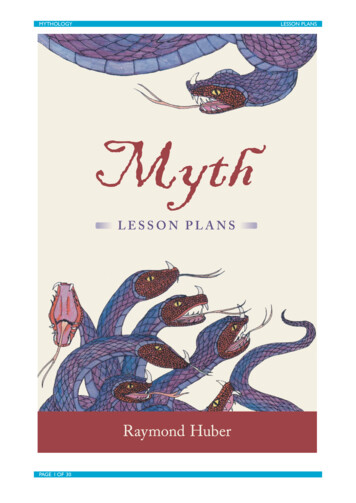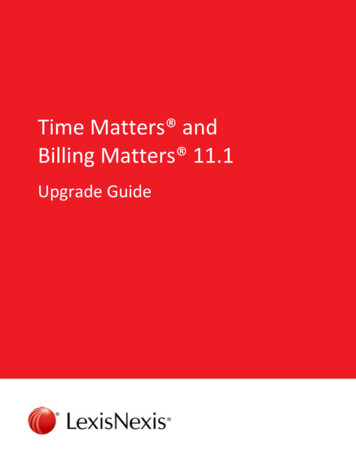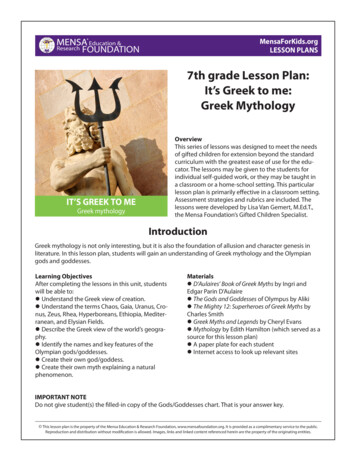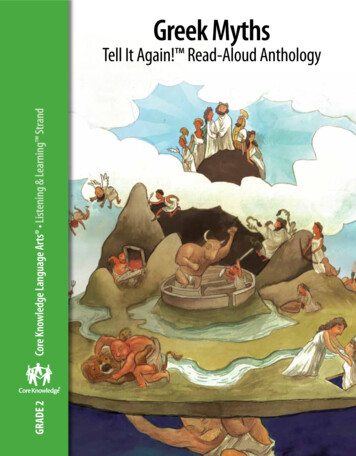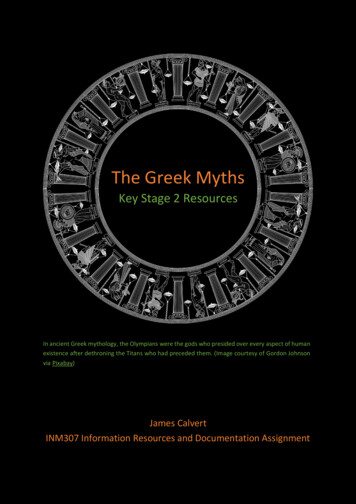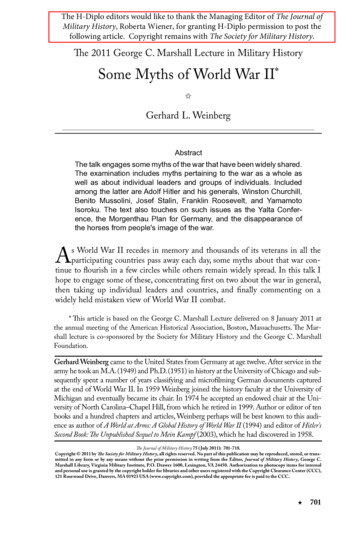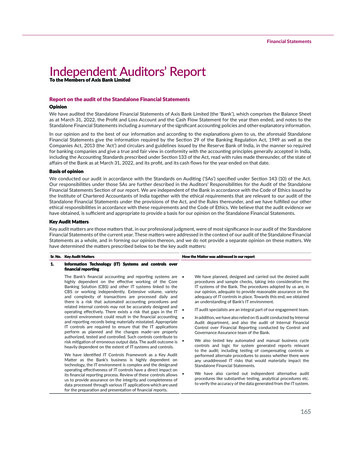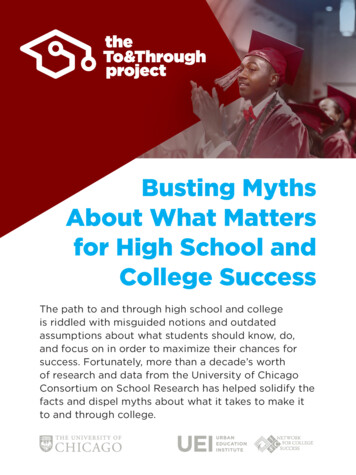
Transcription
Busting MythsAbout What Mattersfor High School andCollege SuccessThe path to and through high school and collegeis riddled with misguided notions and outdatedassumptions about what students should know, do,and focus on in order to maximize their chances forsuccess. Fortunately, more than a decade’s worthof research and data from the University of ChicagoConsortium on School Research has helped solidify thefacts and dispel myths about what it takes to make itto and through college.
MYTH: Students’ academictrajectories are pretty much set bythe time they enter high school:either they’re college-bound atthat point or they’re not.FACTS:Ninth grade is a “make it or break it” year for studentsat all achievement levels. Academic performancesometimes changes dramatically in the shift from eighthto ninth grade, and how students perform in eighthgrade is crucial for eventual high school graduation andcollege readiness. In fact, course performance in theninth grade is more predictive of a student’s odds ofgraduating high school than all other factors, includingrace, gender, socioeconomic status, and prior academicachievement, combined. Freshmen who are “on-track”in the ninth grade, earning five full-year credits and nomore than one semester F in a core class, are nearly fourtimes more likely than their off-track peers to graduatefrom high school. And the main driver of course failureis absences: Course attendance is eight times morepredictive of course failure in the freshman year thaneighth-grade test scores.Allensworth, E., & Easton, J.Q. (2007). What matters for staying on-track and graduating inChicago public high schools: A close look at course grades, failures, and attendance in thefreshman year. University of Chicago Consortium on School Research.Allensworth, E., & Easton, J.Q. (2005). The on-track indicator as a predictor of high schoolgraduation. University of Chicago Consortium on School Research.
MYTH: Missing a dayor two of school eachmonth is no big deal.FACTS:Attendance contributes more than any other factor tocourse failure and low grades. College-ready students(those who have the best chance of enrolling andpersisting in college) have average attendance rates of98 percent, meaning they miss less than a week over thecourse of the entire school year. Yet, in Chicago PublicSchools, 30 percent of ninth-graders are chronicallyabsent, attending school less than 90 percent of thetime. Each week of absence per semester in ninthgrade is associated with a more than 20 percentagepoint decline in the probability of graduating fromhigh school. In light of this, schools are working to helpstudents and families understand the cost of frequentabsences, and using close data monitoring and supportfrom teachers and staff to help students get to class.Rosenkranz, T., et al. (2014). Free to fail or on-track to college: Why grades drop whenstudents enter high school and what adults can do about it. University of Chicago Consortiumon School Research.Allensworth, E., & Easton, J.Q. (2007). What matters for staying on-track and graduating inChicago public high schools: A close look at course grades, failures, and attendance in thefreshman year. University of Chicago Consortium on School Research.Allensworth, E., et al. (2014). Looking forward to high school and college: Middle gradeindicators of readiness in Chicago Public Schools. University of Chicago Consortium on SchoolResearch.
MYTH: ACT and SAT scores arethe most important indicator ofsuccess in college.FACTS:A good ACT or SAT score isn’t a slam dunk for collegesuccess. While ACT/SAT scores matter for collegeaccess, grades (GPAs) are much more predictive ofcollege success. In fact, strong grades—earning Asand Bs in high school—are the strongest indicator ofcollege readiness and are much more predictive ofcollege graduation than any test score. Students with anACT score of 21-23 have about a 50 percent chance ofgraduating college if their high school GPA is between2.5 and 2.9. Yet students with ACT scores in the samerange of 21-23 but with high school GPAs between 3.0and 3.4 graduate college at rates of nearly 70 percent.Healey, K., et al. (2014). The educational attainment of Chicago Public Schools students: Afocus on four-year college degrees. University of Chicago Consortium on School Research.
MYTH: Using class time to prep forthe ACT and SAT is a good way toimprove students’ scores.FACTS:Spending class time on test prep does not makestudents more prepared for the ACT and SAT. In-classtest prep takes time away from developing the higherlevel reasoning skills needed to get better scores.In-class test preparation also tends to be ineffective atraising test scores and can even give a false sense ofthe test and testing conditions. Instead, a challengingacademic atmosphere and a class curriculum thatteaches critical thinking gives students the best shot atsucceeding on the ACT. For students, the most effectiveway to improve ACT scores is to work hard in academicclasses: students who earn As and Bs in their classesmake larger test gains during the year than studentswho get lower grades. To be effective, test prep shouldinvolve full, timed practice tests, and students andteachers or tutors should work together to interpretthe results to figure out what it is that students need towork on to improve their scores.Allensworth, E., et al. (2008). From high school to the future: ACT preparation—too much, toolate. University of Chicago Consortium on School Research.
MYTH: As long as a student’s gradesare strong enough to graduate highschool, GPAs don’t really matter.FACTS:Earning As and Bs matters for success in both highschool and college. Strong grades are a sign thatstudents are able to meet academic challenges, and aredeveloping the skills they need to handle new academicchallenges in the future. More than 95 percent ofstudents with a B average or better their freshman yeargraduate from high school, compared to 72 percent ofstudents with a C average and 28 percent of studentswith a D average. Students may be admitted to somecolleges with less than a 3.0 GPA, but only students whoenter college with a high school GPA of 3.0 or abovehave greater than a 50 percent chance of earning afour-year college degree within six years of graduatinghigh school.Allensworth, E., & Easton, J.Q. (2007). What matters for staying on-track and graduating inChicago public high schools: A close look at course grades, failures, and attendance in thefreshman year. University of Chicago Consortium on School Research.Roderick, M., et al. (2006). From high school to the future: A first look at Chicago publicschool graduates’ college enrollment, college preparation, and graduation from four-yearcolleges. University of Chicago Consortium on School Research.
MYTH: Students who really want to goto college will get there. If they havethe will, they’ll figure out the way.FACTS:76 percent of CPS freshmen aspire to earn a bachelor’sdegree, yet only 42 percent of graduates enroll ina four-year college immediately after completinghigh school. This gap between students’ collegeaspirations and enrollment isn’t unique to Chicago;nationally, 80 percent of high school students aspireto earn a bachelor’s degree, yet only 44 percent enrollimmediately in a four-year college. The gap persists,in large part, because of the “potholes” studentsface along the path to and through college, such asnavigating a complex financial aid application processand sorting through college options to target theirapplications to schools that are a good match for theirqualifications and have strong institutional graduationrates. Helping students overcome barriers like thesecan go a long way toward helping them succeed incollege. For example, students accepted into a four-yearcollege are 50 percent more likely to actually enroll incollege if they have completed their federal financialaid application (FAFSA)—a process that the U.S.Department of Education and many districts have beenworking to streamline.Roderick, M., et al. (2008). From high school to the future: Potholes on the road to college.University of Chicago Consortium on School Research.
MYTH: Talking to students about theircollege plans is primarily a job fortheir school counselors.FACTS:Most high school counselors are responsible forhundreds of students and struggle to find the time toroutinely meet with students one-on-one. Teachers,however, interact with students every day, and cancapitalize on those opportunities to share informationand encouragement. The entire high school has a role toplay in helping students make it to and through collegeby creating a strong college-going culture. In fact, acollege-going culture is the single most consistentpredictor of whether students take steps toward collegeenrollment. Students who attend high schools in whichteachers report a strong college-going culture—wherea school leader has established college attainment as aclear and shared goal for students and where teachersand counselors are involved in supporting students incompleting their college applications—are 12 percentagepoints more likely to apply to and 14 percentage pointsmore likely to enroll in a four-year college than studentswho attend high schools in which teachers do notreport a strong college-going culture.Roderick, M., et al. (2008). From high school to the future: Potholes on the road to college.University of Chicago Consortium on School Research.
MYTH: Starting at a two-year collegeprovides the same opportunity to afour-year degree as starting at afour-year college.FACTS:For students with weaker qualifications, two-yearcolleges are an option that can keep them on a pathtoward a four-year degree. However, students who arehighly qualified for a four-year college have dramaticallylower odds of degree completion if they start at a twoyear college. In Chicago, only 8 percent of studentswho begin at a two-year college complete a bachelor’sdegree within six years of graduating high school.Nearly 90 percent of students who ultimately attain abachelor’s degree enroll in a four-year college directlyafter their senior year of high school. Thus, enrolling in afour-year college directly after high school remains the“surest path” to a bachelor’s degree.Roderick, M., et al. (2006). From high school to the future: A first look at Chicago publicschool graduates’ college enrollment, college preparation, and graduation from four-yearcolleges. University of Chicago Consortium on School Research.Nagaoka, J., & Healey, K. (2016). The educational attainment of Chicago Public Schoolsstudents: 2015: A focus on four-year college degrees. University of Chicago Consortium onSchool Research.
MYTH: A student’s odds ofgraduating college will be the sameat any of the colleges he or she isadmitted to.FACTS:Students of all qualification levels are more likely tograduate from college if they attend a post-secondaryinstitution with a high institutional graduation rate.This is even true for students with strong grades inhigh school; in fact, college choice matters the mostfor students with strong academic qualifications.Ultimately, institutional graduation rates are just onefactor to consider in finding a good college match, butthey can signal to college-bound students how wellthe institutions they’re interested in are able to supportstudents in their quests to graduate from college.Roderick, M., et al. (2008). From high school to the future: Potholes on the road to college.University of Chicago Consortium on School Research.Nagaoka, J., & Healey, K. (2016). The educational attainment of Chicago Public Schoolsstudents: 2015: A focus on four-year college degrees. University of Chicago Consortium onSchool Research.
MYTH: The hardest partof college is getting in.Once you’re in, you’re set.FACTS:Even students who are admitted to college and areacademically well prepared for college can strugglealong the way to their degrees. Colleges that havean institutional culture where administrators, faculty,and staff see it as their role to provide support in thetransition to college can be particularly beneficialfor students who didn’t grow up in contexts wherecollege-going is the norm, such as those who are fromlow-income families or who are first-generation collegegoers. Colleges can support students by tailoringorientation sessions, providing additional counselorsand mentors, ensuring students are enrolling in classesthat lead to degrees, being responsive to financialneeds, and encouraging first-generation students toconnect with each other and with affinity groups.Absent supports, it’s easy for students to fall off track:currently just 11 percent of low-income students whoare the first in their family to attend college earn theirdegrees within six years of enrolling in college.Day, B.J., et al. (forthcoming journal article). “Inside the black box of college match: Theacademic, social, and institutional experiences of high-achieving, urban high schoolgraduates in college.”Engle, J., & Tinto, V. (2008). Moving beyond access: College success for low-income, firstgeneration students. The Pell Institute for the Study of Opportunity in Higher Education.
toandthrough.uchicago.edu
the time they enter high school: either they're college-bound at that point or they're not. Allensworth, E., & Easton, J.Q. (2007). What matters for staying on-track and graduating in Chicago public high schools: A close look at course grades, failures, and attendance in the freshman year. University of Chicago Consortium on School Research.
